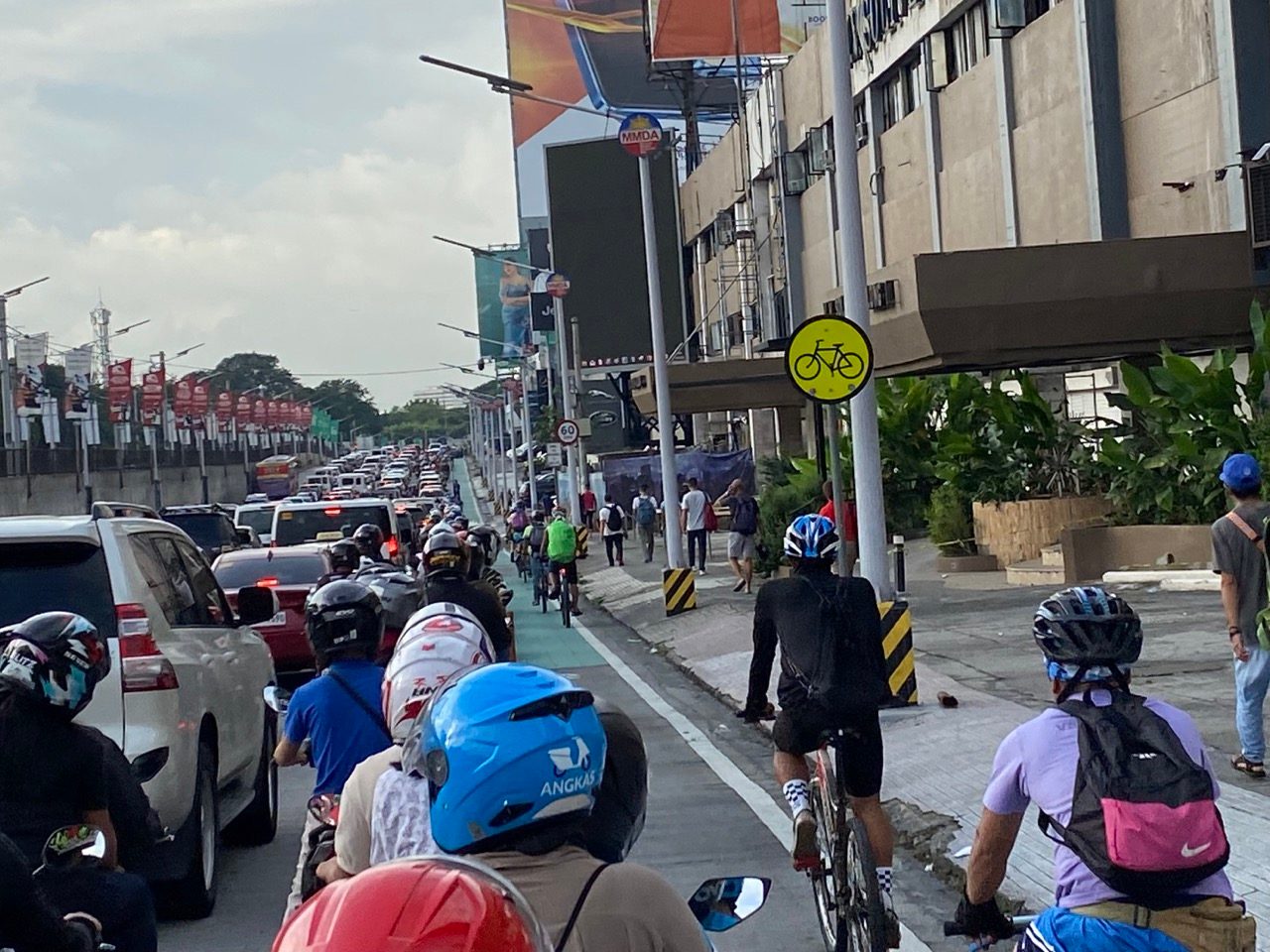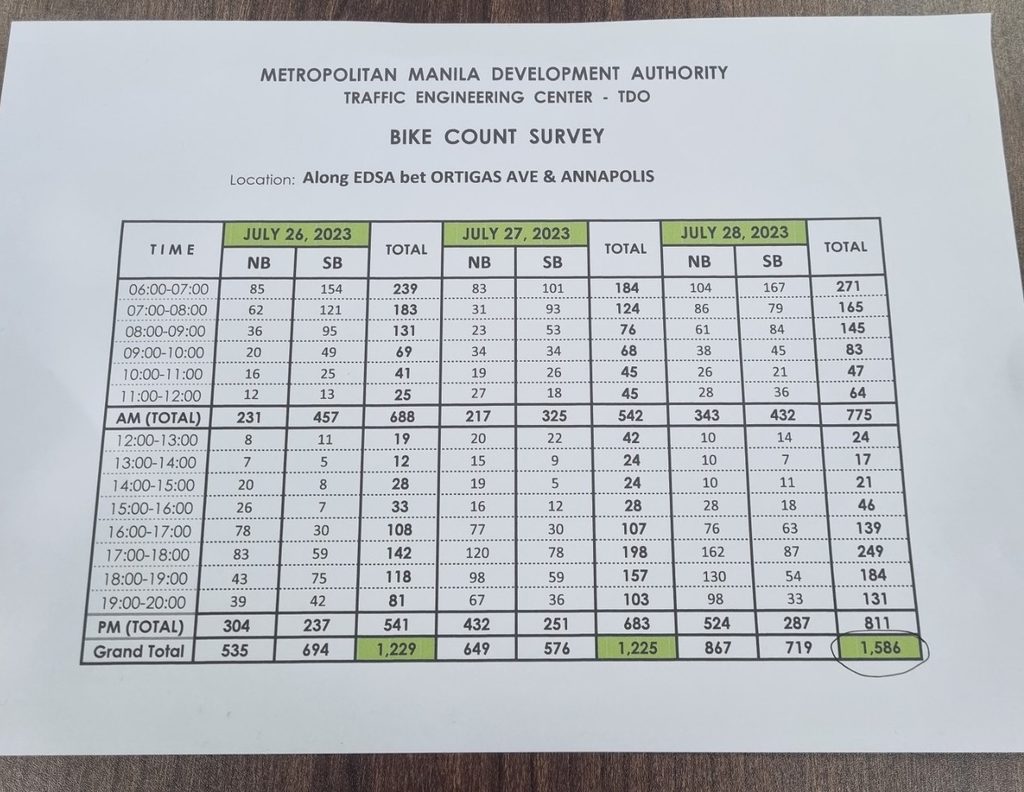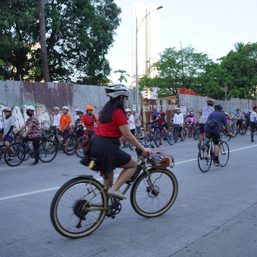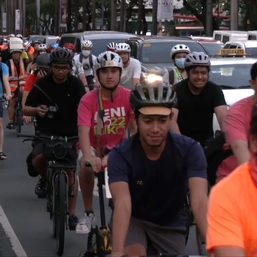SUMMARY
This is AI generated summarization, which may have errors. For context, always refer to the full article.

MANILA, Philippines – Acting Metropolitan Manila Development Authority (MMDA) chairperson Romando Artes has, since March, been stating that “only 1,586 cyclists” traverse the major thoroughfare EDSA on a daily basis.

He has used this figure to justify the MMDA’s opposition to proposals to widen EDSA bike lanes, and on Wednesday, April 24, to explain why the agency is considering proposals to altogether remove or reduce the size of those bike lanes.
“There are many proposals, even to DOTr [Department of Transportation] that say the bike lanes are underutilized. In our data, only 1,500 cyclists use the EDSA bike lane everyday,” he said during the Kapihan sa Manila Bay Forum, as quoted by the Inquirer.
But another major bike count study, conducted by the Institute for Climate and Sustainable Cities (ICSC), The Climate Reality Project Philippines, MNL Moves, 350 Pilipinas, and Pinay Bike Commuter yielded a much higher count of EDSA cyclists: over 7,000.
“Bilang Siklista was able to count more than 7,000 bikers along five key points in EDSA located in Quezon City, Mandaluyong, and San Juan, in just a span of four hours,” said Celine Tabinga of ICSC. The groups above are also behind the Mobility Awards that recognize efforts to promote active and inclusive transport.
Rappler, in a call with MMDA Traffic Engineering Center head Neomie Recio on Thursday, April 25, found that the 1,586 number was obtained by MMDA by counting cyclists from just one spot of EDSA, for one day, on July 28, 2023.

According to Recio, they did this count from 6 am to 8 pm in just one spot of EDSA, somewhere between Ortigas Avenue and Annapolis. They counted every hour during that time period, both on the north-bound and south-bound sides.
The MMDA did two other counts in that same spot on two other dates last year. During a whole-day count on July 26, they counted 1,229 cyclists. On another count on July 27, they counted 1,225 cyclists.
“We focused on that spot because the Department of Transportation is proposing elevated bike lanes in that area,” Recio told Rappler.
Recio admitted the 1,586 is just a partial figure given the limitation of their count. The problem is, MMDA chief Artes now uses this number as a total EDSA bike count.
On the dates MMDA did its bike count, Storm Signal Number 1 was declared over Metro Manila due to Typhoon Egay (Doksuri). Could this account for the much lower bike count? Why did MMDA conduct a bike count during a storm?
The 2023 Bilang Siklista bike count, meanwhile, involved five spots on EDSA and was conducted during two rush -our periods in each day of counting. They counted during the two-hour morning rush hour from 6 am to 8 am, then again from 4 pm to 6 pm.
The count found that up to 7,855 cyclists were on EDSA, and that was only for four hours in one weekday.
It involved 5 intersections of major roads with EDSA and covered both south and north directions on EDSA as well as both directions from EDSA, going into the other major road. The counting was done on June 8, June 15, and June 22 in San Juan, Quezon City, and Mandaluyong City, respectively. EDSA traverses other Metro Manila cities and so this count does not fully capture the number of EDSA cyclists.
Still, even this partial picture already provides a count that is more than MMDA’s current 1,586 cyclists figure.
The 2023 Bilang Siklista study presented a range of cyclists they had counted in those EDSA intersections (for instance, a light orange color would refer to a range of 105 to 210 cyclists counted).
Rappler added up the minimum number in those ranges that referred to counting done explicitly on EDSA. This yielded a total of 4,434, minimum, still almost thrice the MMDA’s count.
Adding up the maximum number of those ranges yields a total of 7,855, based on Rappler’s count. This is almost five times the number MMDA now claims as the total number of daily cyclists traversing EDSA.
The ICSC sent Rappler the exact EDSA count they got, based on single figures and not a range. They counted 7,807 cyclists, not far from the total of the maximum ranges.
The currrent MMDA count is also much less than the 2020 or pandemic-time bike count conducted by the MMDA itself, with ICSC and Manila Moves.
This count found that at an average of 4,060 cyclists were on EDSA daily in the month of June 2020. The counting took place in 6 points along EDSA. The lowest count of cyclists that month was 1,664, close to the 2023 MMDA tally. But the highest count that month far exceeds the MMDA claim – 6,278 cyclists on EDSA on one day.
What is MMDA’s basis for active transport planning?
This discrepancy begs the question: is MMDA formulating plans on policies for bikers based on only a partial count of cyclists? What is the MMDA doing to obtain a more comprehensive and accurate picture of the volume of cyclists who use EDSA daily?
Active transport advocates have long criticized the MMDA for failing to institutionalize its bike counts. Its Annual Average Daily Traffic (AADT) counts cars, buses, jeeps, taxis trucks, tricycles, utility vehicles, trailers, and motorcycles, but does not count bicycles on Metro Manila roads.
Its organizational structure shows only an ad hoc office for active transport, the Bike Lane Program Office currently led by Manuel Barredo, who also heads the Parking Management Team. MMDA has done some bike counts in recent years, with support from various inclusive transport groups. But these are not regular or institutionalized like its AADT.
This seeming lack of support, at times even clear opposition to active transport programs, contradicts the Marcos administration’s national development plan which clearly states cyclists and pedestrians are to be prioritized.
The Philippine Development Plan (PDP) 2023 to 2028, formulated by the National Economic Development Authority, says this on page 281: “Active transport networks will be developed. Pedestrians and cyclists will be accorded highest priority in the hierarchy of road users.”
“Provisions for active mobility will be integrated into the transportation system. Existing thoroughfares and bridges will be redesigned and retrofitted for the protection and expansion of bikers and pedestrians,” it continues.
Public statements of Artes himself have given Metro Manila cyclists the impression that he sees expansion and improvement of active transport infrastructure as unrealistic.
“We have to live in the reality of life here in Metro Manila. We cannot insist on everything we want. And we cannot please everybody here,” he said in the March 11 meeting, to explain MMDA’s opposition to bi-directional protected bike lanes on EDSA.
Artes, in a Tuesday press conference, also claimed that what keeps more Filipinos from biking is the heat and inconvenience of it, rather than safety concerns due to the lack of protected bike lanes in the metro.
“Imaginin mo kung papasok ka sa trabaho. Hindi ka naman pwedeng pumasok na basa, amoy pawis. Sorry ah, pero ‘di ba ‘yon po ‘yung reality eh,” he said.
(Imagine you will go to work. You cannot go to work wet and smelling like sweat. Sorry, but that’s reality.)
How is MMDA protecting cyclists?
But according to transport expert and director of University of the Philippines’ Institute of Civil Engineering Jose Regidor, safety is the primary concern of people who are considering biking as a travel mode.
“Based on what we’ve studied so far, for example, studies done by UP, safety is the number one concern. For people who you want to encourage to bike, if you want to add to people shifting to bicycles, safety is the number one concern,” he told Rappler on March 12.
Regidor is a former director of the UP National Center for Transportation Studies, a think tank that has often been tapped by government agencies for expertise in transportation management.
He also pointed out that many workers, like construction workers or other blue-collar workers, rely on cycling as an affordable mode of transportation, despite the sweat and heat they face on the road, exposed to the elements.
“You have many workers who bike even without a bike lane. They brave it out of necessity because they don’t have money for commuting. If they spend it on public transportation, it eats into their family’s meal budget,” said Regidor.
For this reason, he emphasized the need for an interconnected bike lane network. If MMDA accedes to proposals to remove EDSA bike lanes, the interconnectedness of Metro Manila’s bike lanes would be greatly reduced.
“The main culprit of heavy traffic is the increasing volume of private cars occupying more road space, which must be comprehensively addressed,” said ICSC director for urban development Maria Golda Hilario.
“Making the public transport systems and mass transit infrastructure in Metro Manila interconnected, accessible, comfortable, reliable and efficient is the best and most strategic solution to moving more people and reducing traffic congestion,” she said.
The Move As One Coalition, which advocates for inclusive transportation, called on Artes to “fully adhere to President Marcos Jr.’s policy to support active transportation,” in a Thursday statement. – Rappler.com
Infrastructure that protects cyclists and provides people with more options for mobility is one way to #MakeManilaLiveable. Rappler has a dedicated space for stories about making Philippine cities more liveable, starting with the capital region. Check it out here.
Add a comment
How does this make you feel?



![[Rappler’s Best] Where the streets have no name](https://www.rappler.com/tachyon/2024/03/2-1.jpg?resize=257%2C257&crop=307px%2C0px%2C720px%2C720px)
There are no comments yet. Add your comment to start the conversation.